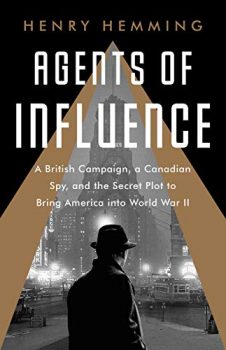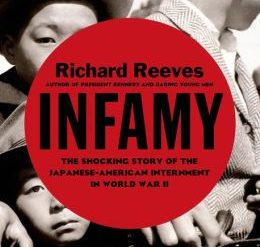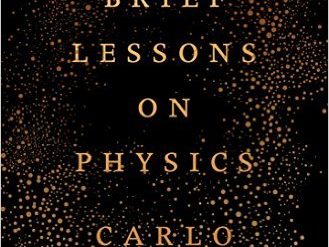
Estimated reading time: 6 minutes
In The Splendid and the Vile, a moving and revealing account of Winston Churchill’s leadership during the Blitz, Erik Larson makes much of the Prime Minister’s dogged campaign to persuade Franklin Roosevelt to drag the United States into the defense of Britain. Historians concur that Churchill’s influence on the President played a major role in bringing about American intervention in the European war. But few observers and analysts remark about another factor that may well have been more decisive: British interference in American politics in 1940 and 41 that helped shift public opinion from isolationism to engagement. Because FDR had perfected to a fine art the practice of “leading from behind.” And that’s central to the story so ably told by Henry Hemming in Agents of Influence.
In 1976, a sensational bestseller titled A Man Called Intrepid hit bookshelves. Written by a Canadian writer named William Stevenson (1924-2013), the book purported to tell the story of William Stephenson (1897-1989), who had run Britain’s MI6 station in New York City during the crucial years 1940-41. (The spy and the author were not related.) Unfortunately, as Hemming reveals in his much more recent book about Stephenson, Intrepid was riddled with inaccuracies, omissions, and exaggerations. Apparently, the writer relied heavily on Stephenson’s own questionable account of his work, which Agents of Influence seeks to dispel. But the real story may be even more dramatic, as recently declassified documents have shown.
Agents of Influence: A British Campaign, a Canadian Spy, and the Secret Plot to Bring America into World War II by Henry Hemming (2019) 401 pages ★★★★★
The real story of British interference in American politics
Working out of New York, Bill Stephenson led a team of undercover agents, sympathetic Americans, and support staff that eventually topped 1,000 in number. Together, they spread fake news, propagated rumors through whispering campaigns, forged documents that undermined America First and vilified Nazi Germany, picketed and disrupted isolationist events, and marshaled public support for FDR to send fifty aged destroyers to Britain and later for Lend-Lease and the Selective Service Act of 1940.
As Hemming writes, “Bill Stephenson had now set up an office dedicated to spreading fake, distorted or inaccurate stories, a rumour factory that was so big, so busy, and was putting out so many stories—on average twenty a day—that he had recently registered it with the State Department under a cover name. . . . Behind this facade was the pre-internet equivalent of a troll farm.” In fact, the British effort was so extensive that its scope would surely dwarf Russian interference in the 2016 Presidential election.
Hemming sums up the result: “When this British influence campaign came to life, shortly after the evacuation from Dunkirk in June 1940, one poll suggested that just 8 per cent of the American population wanted to go to war. Eighteen months later, just weeks before Pearl Harbor, another poll showed that more than two-thirds of Americans had decided it was time to go to war against Nazi Germany.” But this bare-bones summary doesn’t come close to capturing the sheer audacity of British interference in American politics. Hemming terms it “the largest state-sponsored influence campaign ever run on American soil.”
A blue-ribbon cast of characters
To understand the scope of Bill Stephenson’s campaign, consider the cast of leading characters who figure in Agents of Influence:
- Bill Stephenson himself, of course, a millionaire Canadian businessman with a cloudy past recruited as a spy for MI6
- Charles Lindbergh (1902-74), world-famous for his solo flight across the Atlantic in 1927 and the leading figure in the America First isolationist movement in 1940-41; Hemming treats Lindbergh as Stephenson’s principal antagonist
- Wendell Willkie (1892-1944), the maverick Republican candidate for President in 1940 and later a leader in the interventionist forces
- William J. (“Wild Bill”) Donovan, a close friend of FDR and the director of the US Office of Strategic Services (OSS)
- Lord Lothian (1882-1940), the able and well-liked British Ambassador to the United States in 1939-40
- Lord Halifax (1881-1959), Winston Churchill’s “cadaverous” rival in the Cabinet, exiled to America as Lothian’s replacement on his death, serving from December 1940 to May 1946
- New Deal prodigy Adolf Berle (1895-1971), Stephenson’s nemesis in the State Department (“Adolf Berle did not like spies. . . Another of Berle’s pet hates was the British.”)
- Hans Thomsen (1891-1968), Nazi chargé d’affaires in Washington from 1938 until December 11, 1941
This is high drama, indeed. FDR and Churchill themselves as well as Col. Stewart Menzies, “C” in MI6, all figure in the story too, although less prominently.
The biggest surprise in this book
Wild Bill Donovan’s role as director of the OSS is widely known and celebrated. What many fewer people know is that Donovan took on the job of creating the agency with great reluctance. Bill Stephenson recruited him and repeatedly talked him down from running for office (again) or taking some other job. And even when Donovan finally acquiesced to FDR’s invitation and pressure from Stephenson, he took his direction from the Briton. “The most carefully guarded secret inside Donovan’s political warfare section,” Hemming writes, “was that the British were now supplying weekly ‘directives’ telling them roughly what to say and when.” Later—much later, really—the OSS and MI6 grew apart, but in the agency’s early years Donovan led his staff along lines the British traced out. British interference in American politics even extended to helping create and school the agency that became the CIA.
Agents of Influence deftly fills in the gaps of our understanding about exactly why the United States took on the fight against Nazi Germany. Any dispassionate observer looking into the matter early in 1940 would surely have concluded that was unlikely, despite Franklin Roosevelt’s pronounced desire to prevent Britain’s defeat.
For related reading
This is one of the 10 top WWII books about espionage.
Another nonfiction book, The Irregulars: Roald Dahl and the British Spy Ring in Wartime Washington by Jennet Conant( The dashing British spies in wartime Washington), takes up the story of the BSC during the war. And Need to Know: World War II and the Rise of American Intelligence by Nicholas Reynolds (The rise of American intelligence in World War II) places the BSC’s work in a larger context.
I’ve reviewed a great many excellent books about espionage, including More than two dozen good nonfiction books about espionage and The 10 top espionage novels.
If it’s World War II that captivates you, as it does me, you might also be interested in:
- 10 top nonfiction books about World War II
- The 10 best novels about World War II
- The 10 most consequential events of World War II
And you can always find my most popular reviews, and the most recent ones, on the Home Page.



























